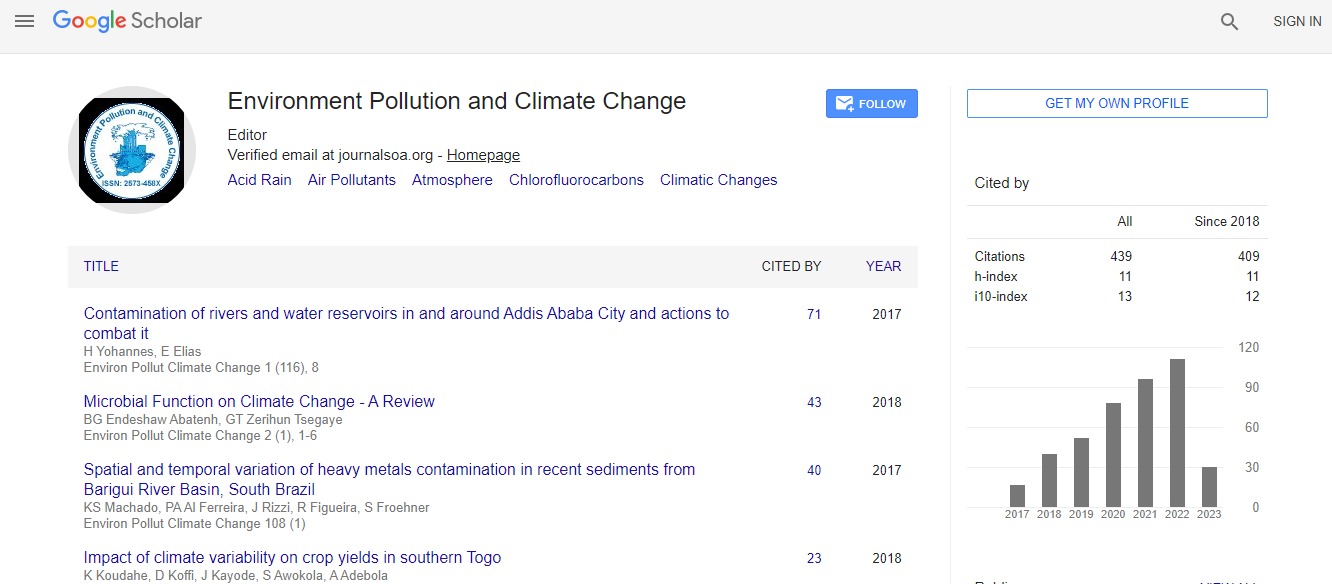Our Group organises 3000+ Global Conferenceseries Events every year across USA, Europe & Asia with support from 1000 more scientific Societies and Publishes 700+ Open Access Journals which contains over 50000 eminent personalities, reputed scientists as editorial board members.
Open Access Journals gaining more Readers and Citations
700 Journals and 15,000,000 Readers Each Journal is getting 25,000+ Readers
Google Scholar citation report
Citations : 672
Environment Pollution and Climate Change received 672 citations as per Google Scholar report
Environment Pollution and Climate Change peer review process verified at publons
Indexed In
- Google Scholar
- Publons
- Euro Pub
- ICMJE
Useful Links
Recommended Journals
Share This Page
Steady shrinking of the Dead Sea as a result of climate change in the Eastern Mediterranean
Joint Event on 5th World Conference on Climate Change & 16th Annual Meeting on Environmental Toxicology and Biological Systems
Pavel Kishcha
Tel Aviv University, Israel
ScientificTracks Abstracts: Environ Pollut Climate Change
Abstract
Statement of the Problem: The coastal area of the hypersaline terminal lake of the Dead Sea is a unique area of dry land of the lowest elevation on Earth (-420 m a.s.l.). The Dead Sea has been drying up over the last four decades: the water level has dropped at the rate of approximately 1 m year. The Dead Sea drying up is due to climate change in the Eastern Mediterranean, which is expressed by the lack of water inflow from the Jordan river, a decreasing tendency in rainfall over the last 40 years and increasing evaporation. Climate change in the Eastern Mediterranean is accompanied by a positive feedback loop between the shrinking of the Dead Sea and the increasing trend in Dead Sea surface temperature (SST) of 0.6°C per decade. This causes increasing evaporation and the continuing disappearance of the Dead Sea. Methodology & Theoretical Orientation: To estimate the effect of climate change in the Eastern Mediterranean on the Dead Sea, we analyzed yearly data of Dead Sea water levels based on available measurements from 1992 until the present. Several factors could influence the observed Dead Sea water level drop, such as long-term changes in evaporation, in SST, in solar radiation and in near-surface wind. To estimate long-term trends in SST, satellite MODIS data were used. Conclusion & Significance: We found that there is a positive feedback loop between Dead Sea shrinking and increasing SST. Additional heating of Dead Sea surface water (as a result of Dead Sea shrinking) is leading to an increase in water evaporation, consequently, to some additional decrease in Dead Sea water levels, eventually to subsequent shrinking of the Dead Sea water area. This positive feedback loop leads to acceleration in the Dead Sea water level drop causing a continuing hazard to this hypersaline lake. Recent Publications 1. Kishcha P, Pinker R, Gertman I, Starobinets B and Alpert P (2018) Observations of positive sea surface temperature trends in the steadily shrinking Dead Sea. Natural Hazards and Earth System Sciences Discussion 2018:1–15. 2. Kishcha P, Starobinets B, Gertman I, Ozer T and Alpert P (2017) Observations of unexpected short-term heating in the uppermost layer of the Dead Sea after a sharp decrease in solar radiation. International Journal of Oceanography 2017:1–12. 3. Kishcha P, Starobinets B, Savir A, Alpert P and Kaplan M (2017) Foehninduced effects on dust pollution, frontal clouds and solar radiation in the Dead Sea valley. Meteorology and Atmospheric Physics 30(3):295–309. 4. Kishcha P, Rieger D, Metzger J, Starobinets B, et al. (2016) Modeling of a strong dust event in the complex terrain of the Dead Sea valley during the passage of a gust front. Tellus B 68:29751. 5. Kottmeier C, Agnon A, Al-Halbounib D, Alpert P, Kishcha P, et al. (2016) New perspectives on interdisciplinary earth science at the Dead Sea: the DESERVE project. Science of the Total Environment 544(2016):1045–1058.Biography
Pavel Kishcha graduated from Lomonosov Moscow State University in 1979 with an MSc in Physics, and received PhD in Geophysics from the Institute of Terrestrial Magnetism, Ionosphere and Radio Wave Propagation (IZMIRAN), Russian Academy of Sciences, Moscow, in 1985. Currently, he is a Senior Research Scientist at the Porter School of Environment and Earth Sciences of Tel-Aviv University (TAU). His research interests include investigation of heating in the uppermost layer of the Dead Sea and long-term trends in Dead Sea surface temperature based on satellite measurements; aerosol physics and aerosol numerical modeling in the atmosphere; aerosol spatial distributions and trends based on satellite and ground-based aerosol measurements. He has been producing daily operational numerical predictions of desert dust storms over the Sahara desert and adjacent regions since 2006. He is the Author of over 50 peer-reviewed publications.
E-mail: pavel@cyclone.tau.ac.il

 Spanish
Spanish  Chinese
Chinese  Russian
Russian  German
German  French
French  Japanese
Japanese  Portuguese
Portuguese  Hindi
Hindi 
